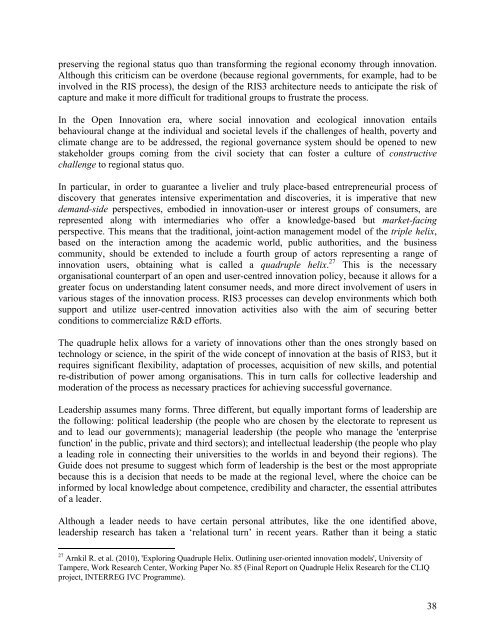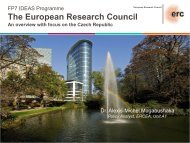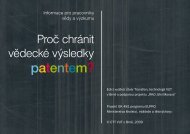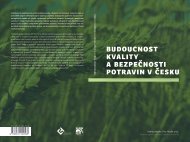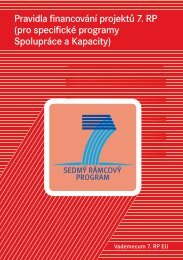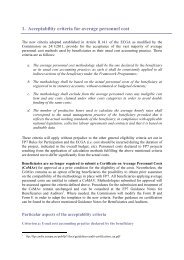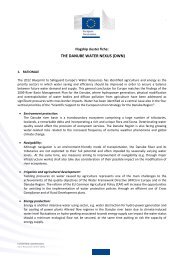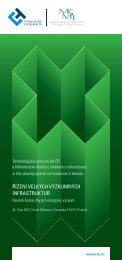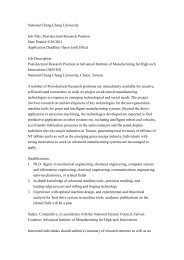Guide to Research and Innovation Strategies for Smart Specialisation
Guide to Research and Innovation Strategies for Smart Specialisation
Guide to Research and Innovation Strategies for Smart Specialisation
You also want an ePaper? Increase the reach of your titles
YUMPU automatically turns print PDFs into web optimized ePapers that Google loves.
preserving the regional status quo than trans<strong>for</strong>ming the regional economy through innovation.<br />
Although this criticism can be overdone (because regional governments, <strong>for</strong> example, had <strong>to</strong> be<br />
involved in the RIS process), the design of the RIS3 architecture needs <strong>to</strong> anticipate the risk of<br />
capture <strong>and</strong> make it more difficult <strong>for</strong> traditional groups <strong>to</strong> frustrate the process.<br />
In the Open <strong>Innovation</strong> era, where social innovation <strong>and</strong> ecological innovation entails<br />
behavioural change at the individual <strong>and</strong> societal levels if the challenges of health, poverty <strong>and</strong><br />
climate change are <strong>to</strong> be addressed, the regional governance system should be opened <strong>to</strong> new<br />
stakeholder groups coming from the civil society that can foster a culture of constructive<br />
challenge <strong>to</strong> regional status quo.<br />
In particular, in order <strong>to</strong> guarantee a livelier <strong>and</strong> truly place-based entrepreneurial process of<br />
discovery that generates intensive experimentation <strong>and</strong> discoveries, it is imperative that new<br />
dem<strong>and</strong>-side perspectives, embodied in innovation-user or interest groups of consumers, are<br />
represented along with intermediaries who offer a knowledge-based but market-facing<br />
perspective. This means that the traditional, joint-action management model of the triple helix,<br />
based on the interaction among the academic world, public authorities, <strong>and</strong> the business<br />
community, should be extended <strong>to</strong> include a fourth group of ac<strong>to</strong>rs representing a range of<br />
innovation users, obtaining what is called a quadruple helix. 27 This is the necessary<br />
organisational counterpart of an open <strong>and</strong> user-centred innovation policy, because it allows <strong>for</strong> a<br />
greater focus on underst<strong>and</strong>ing latent consumer needs, <strong>and</strong> more direct involvement of users in<br />
various stages of the innovation process. RIS3 processes can develop environments which both<br />
support <strong>and</strong> utilize user-centred innovation activities also with the aim of securing better<br />
conditions <strong>to</strong> commercialize R&D ef<strong>for</strong>ts.<br />
The quadruple helix allows <strong>for</strong> a variety of innovations other than the ones strongly based on<br />
technology or science, in the spirit of the wide concept of innovation at the basis of RIS3, but it<br />
requires significant flexibility, adaptation of processes, acquisition of new skills, <strong>and</strong> potential<br />
re-distribution of power among organisations. This in turn calls <strong>for</strong> collective leadership <strong>and</strong><br />
moderation of the process as necessary practices <strong>for</strong> achieving successful governance.<br />
Leadership assumes many <strong>for</strong>ms. Three different, but equally important <strong>for</strong>ms of leadership are<br />
the following: political leadership (the people who are chosen by the elec<strong>to</strong>rate <strong>to</strong> represent us<br />
<strong>and</strong> <strong>to</strong> lead our governments); managerial leadership (the people who manage the 'enterprise<br />
function' in the public, private <strong>and</strong> third sec<strong>to</strong>rs); <strong>and</strong> intellectual leadership (the people who play<br />
a leading role in connecting their universities <strong>to</strong> the worlds in <strong>and</strong> beyond their regions). The<br />
<strong>Guide</strong> does not presume <strong>to</strong> suggest which <strong>for</strong>m of leadership is the best or the most appropriate<br />
because this is a decision that needs <strong>to</strong> be made at the regional level, where the choice can be<br />
in<strong>for</strong>med by local knowledge about competence, credibility <strong>and</strong> character, the essential attributes<br />
of a leader.<br />
Although a leader needs <strong>to</strong> have certain personal attributes, like the one identified above,<br />
leadership research has taken a ‘relational turn’ in recent years. Rather than it being a static<br />
27 Arnkil R. et al. (2010), 'Exploring Quadruple Helix. Outlining user-oriented innovation models', University of<br />
Tampere, Work <strong>Research</strong> Center, Working Paper No. 85 (Final Report on Quadruple Helix <strong>Research</strong> <strong>for</strong> the CLIQ<br />
project, INTERREG IVC Programme).<br />
38


